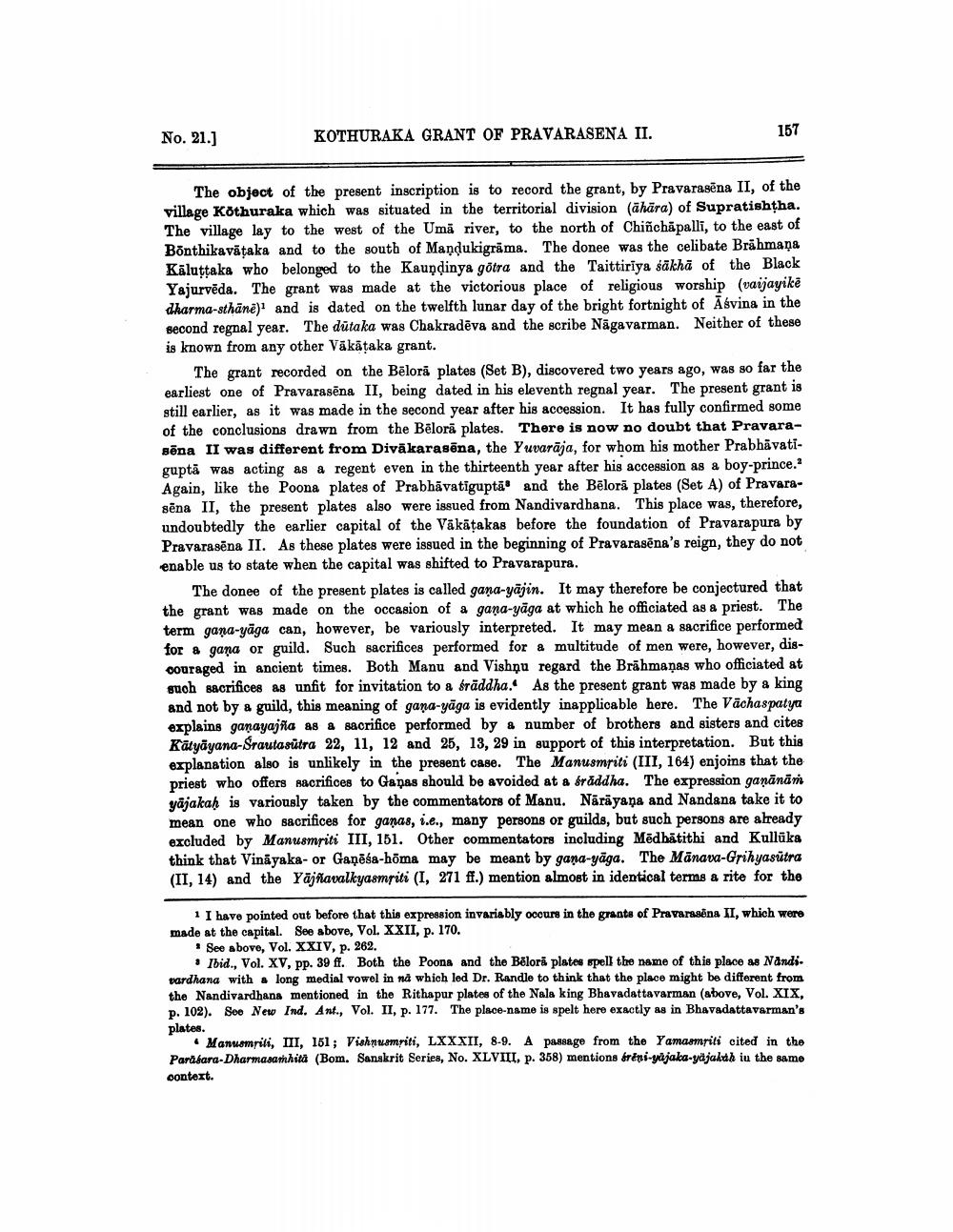________________
No. 21.)
KOTHURAKA GRANT OF PRAVARASENA II.
157
The object of the present inscription is to record the grant, by Pravarasēna II, of the village Kothuraka which was situated in the territorial division (ähära) of Supratishtha. The village lay to the west of the Umā river, to the north of Chiñchäpalli, to the east of Bönthikavitaka and to the south of Mandukigrama. The donee was the celibate Brāhmana Kāluttaka who belonged to the Kaundinya götra and the Taittiriya sākha of the Black Yajurvēda. The grant was made at the victorious place of religious worship (vaijayikê dharma-sthānē) and is dated on the twelfth lunar day of the bright fortnight of Ābvina in the second regnal year. The dutaka was Chakradēva and the scribe Nägavarman. Neither of these is known from any other Vākātaka grant.
The grant recorded on the Bēlorā plates (Set B), discovered two years ago, was so far the earliest one of Pravarasēna II, being dated in his eleventh regnal year. The present grant is still earlier, as it was made in the second year after his accession. It has fully confirmed some of the conclusions drawn from the Bēlorā plates. There is now no doubt that PravaraBēna II was different from Divākarasēna, the Yuvarāja, for whom his mother Prabhāvatigupta was acting as a regent even in the thirteenth year after his accession as a boy-prince.* Again, like the Poona plates of Prabhāvatigupta and the Bēloră plates (Set A) of Pravarasēna II, the present plates also were issued from Nandivardhana. This place was, therefore, undoubtedly the earlier capital of the Vākātakas before the foundation of Pravarapura by Pravarasēna II. As these plates were issued in the beginning of Pravarasēna's reign, they do not enable us to state when the capital was shifted to Pravarapura.
The donee of the present plates is called gana-vājin. It may therefore be conjectured that the grant was made on the occasion of a gana-yāga at which he officiated as a priest. The term gana-yāga can, however, be variously interpreted. It may mean a sacrifice performed for a gana or guild. Such sacrifices performed for a multitude of men were, however, discouraged in ancient times. Both Manu and Vishnu regard the Brähmanas who officiated at such sacrifices as unfit for invitation to a śräddha. As the present grant was made by a king and not by a guild, this meaning of gana-yāga is evidently inapplicable here. The Vāchaspatya explains ganayajsia as a sacrifice performed by a number of brothers and sisters and cites Kätyāyana-Srautasütra 22, 11, 12 and 25, 13, 29 in support of this interpretation. But this explanation also is unlikely in the present case. The Manusmriti (III, 164) enjoins that the priest who offers sacrifices to Ganas should be avoided at a frāddha. The expression gaņānāri yajakaḥ is variously taken by the commentators of Manu. Nārāyaṇa and Nandana take it to mean one who sacrifices for ganas, i.e., many persons or guilds, but such persons are already excluded by Manusmriti III, 151. Other commentators including Mēdbätithi and Kullüka think that Vinayaka- or Gaņēša-hõma may be meant by gana-yāga. The Mänava-Grihyasutra (II, 14) and the Yājflavalkyasmriti (I, 271 ff.) mention almost in identical terms a rite for the
1 I have pointed out before that this expression invariably occurs in the grants of Pravarasina II, which were made at the capital. See above, Vol. XXII, p. 170.
· See above, Vol. XXIV, p. 262.
• Ibid., Vol. XV. pp. 39 ff. Both the Poons and the Belor, plates spell the name of this place as Nandivardhana with long medial vowel in nd which led Dr. Randle to think that the place might be different from the Nandivardhans mentioned in the Rithapur plates of the Nala king Bhavadattavarman (above, Vol. XIX, p. 102). See New Ind. Ant., Vol. II, p. 177. The place-name is spelt here exactly as in Bhavadattavarman's plates.
4 Manuemriti, III, 151; Vishnwamriti, LXXXII, 8-9. A passage from the Yamaamriti cited in the Panalara-Dharmasarhita (Bom. Sanskrit Series, No. XLVIII, p. 368) mentions freni-yajaka-ydjaldh iu the same context.




